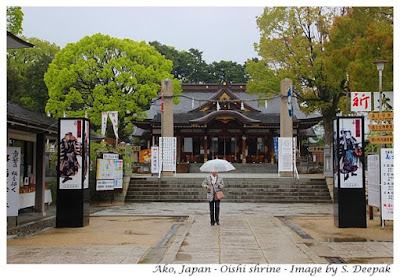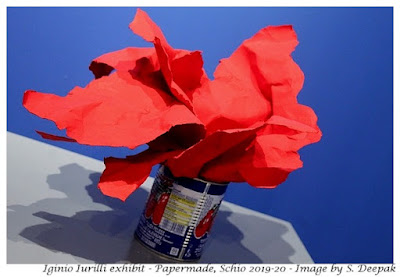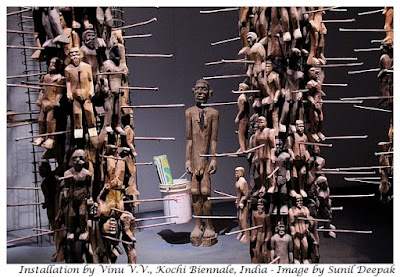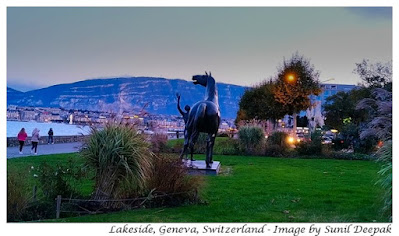This post is about surgery in ancient India and how it could have given birth to the Ganesha myth.
In the Indian mythology, Ganesha is the son of Shiva and Parvati, born while his father is away. Many years later, one day Shiva comes back home and is stopped by Ganesha, who does not know him and is guarding the door because his mother is taking bath. Angry, Shiva cuts his head. Later when he realises his mistake, it is too late, some animal has eaten his son's head. So Shiva sends his men to look for another head, and his men bring back the head of a baby elephant which is put on the boy's torso. This is how Ganesha's elephant head is explained in the mythology.
The Ganesha Story
I love the figure of Ganesha. For me, it symbolises the omnipresent links between humans and different aspects of nature, which permeate different aspects of Hinduism. They teach us to look with respect at every aspect of nature - from the microscopic bacteria and ants to animals and plants, and even the snow covered mountains. If you have seen individuals in India offering flour or grains to ants and snakes and monks going around with a mask for their mouths, you can understand the vitality of this link between Indic religions and nature.In the Indian mythology, Ganesha is the son of Shiva and Parvati, born while his father is away. Many years later, one day Shiva comes back home and is stopped by Ganesha, who does not know him and is guarding the door because his mother is taking bath. Angry, Shiva cuts his head. Later when he realises his mistake, it is too late, some animal has eaten his son's head. So Shiva sends his men to look for another head, and his men bring back the head of a baby elephant which is put on the boy's torso. This is how Ganesha's elephant head is explained in the mythology.
Transplanting An Animal Head
Some persons take the Ganesha story literally and believe that ancient Indians knew how to transplant an animal head on that of a human being. Even if it was possible to sew and transplant an animal head on a human body, and even if it was possible to avoid the inter-species transplant rejection, no real elephant's head, not even a baby elephant head, can fit the human body, unless we are talking of elephant-sized giant men from Gulliver's Travels. Thus, this story is only a story.However, ancient Indians did develop surgical skills almost 2000 years ago, which were probably unique in the world at that time. Some of those techniques are still used in modern surgery. I wonder if the story of one such surgical operation could have given birth to the Ganesha myth. Let me explain.
Surgery in Ancient India
Mentions of surgery are found from Rigveda onwards in different texts of Hinduism and some of the well known ancient surgeons mentioned in these texts include Ashwini Kumaras, Chavana, Dhanvantari, Atereya Agnivesh and Sushruta. Sushruta from 600 BCE is called the father of Indian surgery, and his book known as Sushruta Samhita contains indications regarding cosmetic, plastic, and dental surgery ("Sandhan Karma").Dr. Vibha Singh in an article published in the Journal of Maxillofacial Surgery in 2017 had written about it:
The ancient surgical science was known as Shalya Tantra. Shalya means broken arrow or a sharp part of a weapon and Tantra means maneuver. Shalya Tantra embraces all processes, aiming at the removal of factors responsible for producing pain or misery to the body or mind. Since warfare was common then, the injuries sustained led to the development of surgery as refined scientific skill ...
Complicated surgeries such as cesarean, cataract, artificial limb, fractures, urinary stones plastic surgery, and procedures including per- and post-operative treatment along with complications written in Sushrutaa Samhita, which is considered to be a part of Atharva Veda, are surprisingly applicable even in the present time ...
Even today, rhinoplasty described by Shushruta in 600 BC is referred to as the Indian flap and he is known as the originator of plastic surgery. Besides trauma involving general surgery, Sushruta gives an in-depth account and a description of the treatment of 12 varieties of fracture and six types of dislocation. This continues to spellbind orthopedic surgeons even today. He mentions the principles of traction, manipulation, apposition, stabilization, and postoperative physiotherapy ...
Knowledge about surgery travelled from India to the Arab World in the 8th CE and then to Europe. Prof. Thamburaj in his book Textbook of Contemporary Neurosurgery wrote that Sushruta Samhita was translated into Arabic as 'Kitab Shah Shun al–Hindi' and 'Kitab–I–Susurud'. There were Latin and German translations of this text in early 19th century but I think that there must have other translations of this text in the past and the knowledge about the Indian techniques had reached Europe much earlier.
Dr Frank McDowell in his 1977 book on Plastic Surgery had written: "Through all of Sushruta's flowery language, incantations and irrelevancies, there shines the unmistakable picture of a great surgeon. Undaunted by his failures and unimpressed by his successes, he sought the truth unceasingly and passed it on to those who followed. He attacked diseases and deformities definatively, with reasoned and logical methods. When the path did not exist, he made one."
The Skin Grafting Technique from India
Skin grafts are needed when the skin is destroyed, such as in burn and crush injuries. Broadly, there are two kinds of skin grafts - a partial skin graft and a full skin graft. The full skin grafts were described in Sushruta Samhita.When wounds are big or deeper, and a thin strip of skin is not enough, we need a graft with the full depth of the skin and underlying tissues including blood vessels and nerves. For this, the surgeons cut a piece of full skin tissue from three sides, usually from abdomen, arms or thighs, while making sure that it remains attached on the 4th side to the original part of the body, from where it can continue to receive blood. This skin flap is used to cover the wound. This means, the surgeon needs to bring together the wound to the body part which is going to donate the skin, and they need to stay together for some weeks, till the grafted skin starts getting blood from the underlying tissues. Once the grafted skin is well fixed to the new area, the flap can be cut at the base and two parts can be separated.
The Origins of Ganesha Myth
Is it possible that the Ganesha myth started from a surgery in ancient India? Lets suppose that there was a young boy who was a priest at a Shiva or Shakti temple and he was attacked by someone who wanted to loot the temple. He was able to protect the temple but his nose was cut during the fight. He was operated by a surgeon who took a full skin flap from his upper arm and used it to construct a nose for him. After the operation, he was forced to keep his arm close to his face with his forearm hanging in front of his face like an elephant's trunk for a few weeks or months. Suppose, someone called him the boy with the elephant's head and over time, it gave rise to the Ganesha story?Hinudism has a strong traditions of an oral culture, where old stories are made into songs, adapted to the local context and passed across generations. Over centuries, such a story could have become the Ganesha's mythical story and the sages incorporated that story in a sacred book, explaining him to be Shiva and Parvati's son.
Conclusions
Hinduism is a living tradition that has roots going back to antiquity. This living tradition is incredibly complex, where each story has innumerable versions, and some of them can be contradictory. Over centuries, stories which can have deep metaphorical meanings become widespread and find a place in one of its sacred texts.Additional notes about this surgery in India are given below: I think that this additional information is important because it shows that Ayurvedic operations based on the ancient techniques described in old books of Sushruta Samhita and Charaka Samhita, were being practiced in India in 18th century and were taken to west much more recently than has been claimed.
Additional Notes, 11 August 2020 (From @trueindologyorg on Instagram):
The above is the picture of world's first known modern plastic surgery. It is also the picture of world's first known modern nose job. It was performed by a traditional Indian surgeon named Kumar. The person in this picture was known as Cowasji. He was a Maratha bullock driver. He had been imprisoned by Tipu Sultan and his nose was cut off in prison. His nose was later restored by a traditional Surgeon named Kumar using "ancient Indian methods" in 1794 CE.
A Britisher named Lucas observed in action the traditional Indian surgery of Cowasji and documented every detail of this operation. This picture was a British portrait of Cowasji AFTER Rhinoplasty (c. 1795 CE). At that time, the Europeans lacked the scientific knowledge and expertise needed to perform plastic surgery. They were greatly intrigued by this method and found it was commonly performed in India. They also noted how Susruta Samhita described this procedure of Rhinoplasty in detail. These details were then accessed by a scientist named Joseph Constantine Carpue. Using these techniques, he performed world's "first" modern Rhinoplasty 20 years later.
Joseph Constantine Carpue is widely known as the father of Plastic Surgery. But in his book "An account of two successful operations" , he acknowledges that it was performed by "Indians from time immemorial". He learnt it through his friends who "copied from Hindoo practitioners" in his own words. Nasal reconstructions had been practiced as a relatively routine procedure in India for centuries. The procedures are described in two well-known early Indian medical works like the Suśruta Samhitā. By the nineteenth century, the technique had been handed down through families.
Traditional Indian sources recommend that Kumbhakaras (potters) perform the surgery owing to their skill. They performed it till 18th century. Source: "An account of two successful operations " by Joseph Constantine Carpue. Image source: https://blogs.bl.uk/science/2016/10/britains- first-nose-job.html
*****
A Britisher named Lucas observed in action the traditional Indian surgery of Cowasji and documented every detail of this operation. This picture was a British portrait of Cowasji AFTER Rhinoplasty (c. 1795 CE). At that time, the Europeans lacked the scientific knowledge and expertise needed to perform plastic surgery. They were greatly intrigued by this method and found it was commonly performed in India. They also noted how Susruta Samhita described this procedure of Rhinoplasty in detail. These details were then accessed by a scientist named Joseph Constantine Carpue. Using these techniques, he performed world's "first" modern Rhinoplasty 20 years later.
Joseph Constantine Carpue is widely known as the father of Plastic Surgery. But in his book "An account of two successful operations" , he acknowledges that it was performed by "Indians from time immemorial". He learnt it through his friends who "copied from Hindoo practitioners" in his own words. Nasal reconstructions had been practiced as a relatively routine procedure in India for centuries. The procedures are described in two well-known early Indian medical works like the Suśruta Samhitā. By the nineteenth century, the technique had been handed down through families.
Traditional Indian sources recommend that Kumbhakaras (potters) perform the surgery owing to their skill. They performed it till 18th century. Source: "An account of two successful operations " by Joseph Constantine Carpue. Image source: https://blogs.bl.uk/science/2016/10/britains- first-nose-job.html
*****
#surgery #medicine #ayurveda #ancientindia #ganesha #hinduism





















































